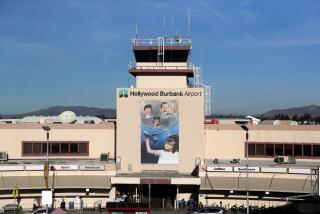Congress in the Cockpit
- Share via
The first goal of commercial airports should be to provide a place for airliners to take off and land safely. Such decisions primarily are the province of the Federal Aviation Administration, the airlines and the airline pilots. This is the way it should be. When Congress tries to get into the act, it is strictly out in left field.
The case in question is the Burbank-Glendale-Pasadena Airport, once the old Lockheed Terminal, on Hollywood Way in Burbank. The problem is noise. Specifically, most of the passenger-jet flights now take off from north to south over a slice of Burbank and then turn west over territory of the City of Los Angeles: North Hollywood, Sherman Oaks, Studio City and Van Nuys.A movement is afoot in Los Angeles to “share the noise,” and would require at least half the planes to take off to the east, over portions of Burbank and Glendale.
The controversy has reached the point that Rep. Howard L. Berman (D-Panorama City) has inserted language in an airport aid bill that seeksto force half the ascending flights away from his district and over at least some of the Burbank-Glendale-Pasadena complex that actually owns and operates the airport. The effect of the measure would be to withhold federal improvement funds from the airport until the shift is implemented.
This might seem fair, if the only issue was noise. But FAA and airline officials claim that takeoffs to the east are less safe because the runway is 900 feet shorter, at only 6,000 feet, and the planes have to climb rapidly over the Verdugo Mountains. The problem is compounded by the fact that the prevailing winds are from the west. Standard safe aviation practice is to take off into the wind to give the airplane greater lift.
Actually, there would be no immediate effect from the Berman language. No west-to-east takeoffs are permitted pending relocation of the new terminal building, although there are occasional east-to-west takeoffs under certain wind conditions. Berman’s bill would allow both FAA controllers and pilots to veto an eastbound takeoff if they felt it unsafe. And Berman acknowledged that his main objective was to force the airport management to “get serious” about developing an anti-noise plan. Airport authority president Robert W. Garcin claims that Burbank has solved the noise problem. “We have the quietest fleet of planes in the country going in and out of this airport,” he said.
Noise is a serious complaint at all Los Angeles regional airports. Airport managements and the airlines have adopted costly--and sometimes perhaps even risky--procedures to combat the problem, including steep takeoffs and sharp turns to limit noise over heavily populated areas. Operating hours are limited. Noisier planes are banned from Orange County and Long Beach airports as well. Every community is obligated to do what it can to reduce noise to the minimum, for its neighbors as well as for its own residents, without jeopardizing safety.
Noise is part of the price that society pays for demanding air service at nearby airports, and Los Angeles residents are among those who enjoy the proximity and economic benefits of the Burbank airport. The problems of noise, congestion and safety will continue at all the region’s airports as long as more passengers demand more flights to more destinations. The long-range solution lies in sound planning on a regional basis and construction of additional airports. There is an area in which Congress can take a constructive role. But it should stay out of the cockpit.
More to Read
Get the L.A. Times Politics newsletter
Deeply reported insights into legislation, politics and policy from Sacramento, Washington and beyond. In your inbox twice per week.
You may occasionally receive promotional content from the Los Angeles Times.










